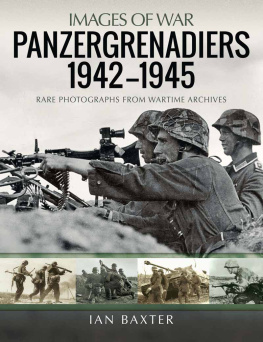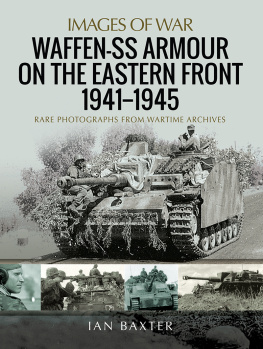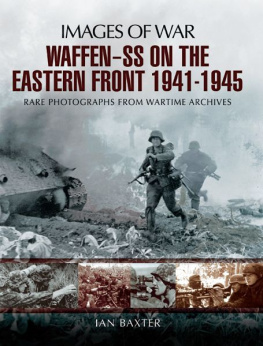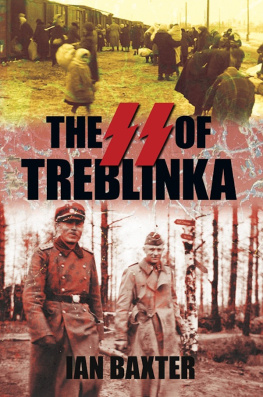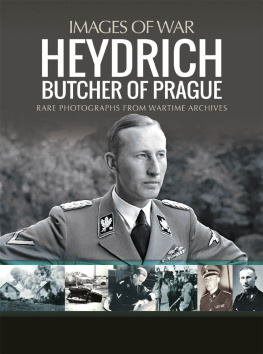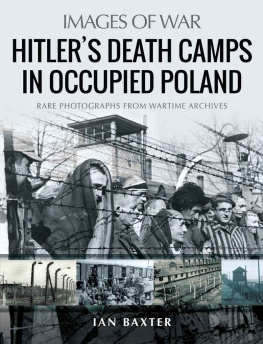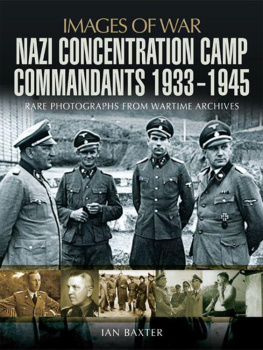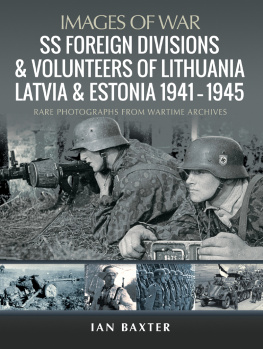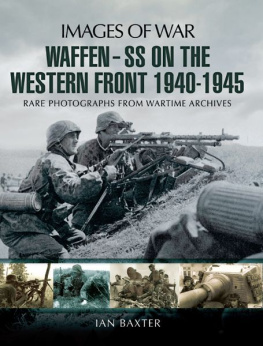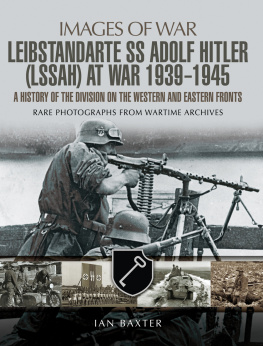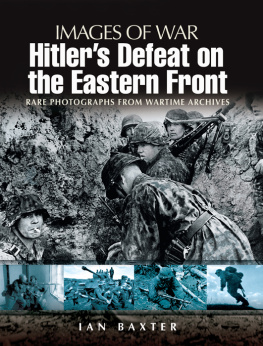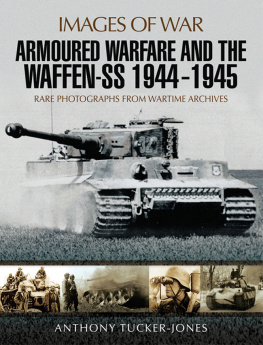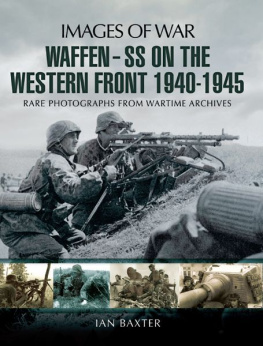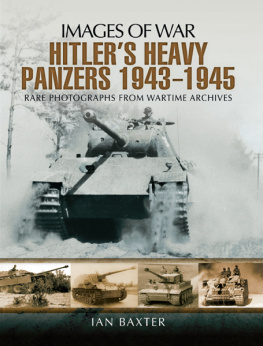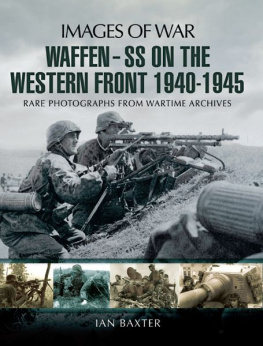Pagebreaks of the print version

IMAGES OF WAR
PANZERGRENADIERS AT WAR 19421945
RARE PHOTOGRAPHS FROM WARTIME ARCHIVES
Ian Baxter

First published in Great Britain in 2021 by
PEN & SWORD MILITARY
an imprint of
Pen & Sword Books Ltd
47 Church Street
Barnsley
South Yorkshire
S70 2AS
Copyright Ian Baxter, 2021
ISBN 978-1-39900-374-2
eISBN 978-1-39900-375-9
Mobi ISBN 978-1-39900-376 6
The right of Ian Baxter to be identified as author of this work has been asserted by him in accordance with the Copyright, Designs and Patents Act 1988.
A CIP catalogue record for this book is available from the British Library.
All rights reserved. No part of this book may be reproduced or transmitted in any form or by any means, electronic or mechanical including photocopying, recording or by any information storage and retrieval system, without permission from the Publisher in writing.
Pen & Sword Books Limited incorporates the imprints of Atlas, Archaeology, Aviation, Discovery, Family History, Fiction, History, Maritime, Military, Military Classics, Politics, Select, Transport, True Crime, Air World, Frontline Publishing, Leo Cooper, Remember When, Seaforth Publishing, The Praetorian Press, Wharncliffe Local History, Wharncliffe Transport, Wharncliffe True Crime and White Owl.
For a complete list of Pen & Sword titles please contact
PEN & SWORD BOOKS LIMITED
47 Church Street, Barnsley, South Yorkshire S70 2AS, England
E-mail:
Website: www.pen-and-sword.co.uk
About the Author
I an Baxter is a military historian who specialises in German twentieth-century military history. He has written more than fifty books including Poland The Eighteen Day Victory March , Panzers In North Africa , The Ardennes Offensive , The Western Campaign , The 12th SS Panzer-Division Hitlerjugend , The Waffen-SS on the Western Front , The Waffen-SS on the Eastern Front , The Red Army at Stalingrad , Elite German Forces of World War II , Armoured Warfare , German Tanks of War , Blitzkrieg , Panzer-Divisions at War , Hitlers Panzers , German Armoured Vehicles of World War Two , Last Two Years of the Waffen-SS at War , German Soldier Uniforms and Insignia , German Guns of the Third Reich , Defeat to Retreat: The Last Years of the German Army At War 194345 , Operation Bagration the Destruction of Army Group Centre , German Guns of the Third Reich , Rommel and the Afrika Korps , U-Boat War , and most recently The Sixth Army and the Road to Stalingrad . He has written over a hundred articles including Last days of Hitler, Wolfs Lair, The Story of the V1 and V2 Rocket Programme, Secret Aircraft of World War Two, Rommel at Tobruk, Hitlers War With his Generals, Secret British Plans to Assassinate Hitler, The SS at Arnhem, Hitlerjugend, Battle of Caen 1944, Gebirgsjager at War, Panzer Crews, Hitlerjugend Guerrillas, Last Battles in the East, The Battle of Berlin, and many more. He has also reviewed numerous military studies for publication, supplied thousands of photographs and important documents to various publishers and film production companies worldwide, and lectures to various schools, colleges and universities throughout the United Kingdom and the Republic of Ireland.
Introduction
The Panzergrenadiers
I n 1942, the second year of the war on the eastern front, a reorganization of the German army was adopted. Infantry regiments were renamed Grenadier regiments with the Schtzen regiments (infantry in Panzer divisions were known as Schtzen regiments) being redesignated as Panzergrenadier regiments, along with the motorized (mot.) infantry units and the soldiers within them.
The use of Panzergrenadiers initially evolved from using motorized infantry divisions and upgrading them into the new Panzergrenadier (PzGren) Divisions. These new divisions retained their numerical designations. Often the divisions adopted a divisional symbol as a way of giving them a new identity on the battlefield and separating themselves from their mother infantry division.
The PzGren divisions were often organized with six battalions of lorry-mounted infantry organized into either two or three regiments, a battalion of Panzers, and a complement of reconnaissance, artillery, anti-tank (PaK), anti-aircraft (FlaK), and combat formations. All these would also be mechanized within the division and well equipped with PaK and FlaK units towed by trucks, heavy assault guns (one armoured regiment with three battalions of fourteen assault guns in each), and armoured personnel carriers, usually the Sd.Kfz.251 halftrack.
Theoretically a typical Panzergrenadier division had one tank battalion less than a Panzer division but two more infantry battalions. The composition of the division made it very powerful, almost as strong as a Panzer division.
The troops travelled by motor vehicle rather than on foot, as speed and penetration of enemy positions was paramount. Because of their mobility and the fact that they usually found themselves thrust into battle alongside armoured units, they were considered elite frontline formations. Sometimes they were known as Gummi Panzergrenadier (rubber Panzergrenadier) as they travelled in halftracks, which offered armour protection and mobility until they were close enough to attack enemy positions on foot. The use of motorized infantry was an example of rapid tactical deployment that would change the way that battles were fought forever. These troops were trained to always be on the move. They were often supported by advancing armour, protecting their flanks, and sometimes they were dropped into the middle of a battle which had just been won to mop up a bewildered and shocked foe.
Chapter One
Birth of the Panzergrenadiers
T he German army was made up of heavy infantry, light (Schtzen) units, security (Sicherung) or police units, and various types of Jger formations. Although the standard infantry formation was paramount to the conduct of operations, often advancing in the wake of the Panzer divisions, by 1942 it was considered that techniques had to change in fighting against the Red Army on the eastern front.
As early as the Blitzkrieg years of 193941 it was realised how vital motorized infantry was. While the bulk of German infantry remained on foot, still using animals for its main form of transport, the armoured divisions were mechanized, using wheeled and tracked vehicles against their enemy. The integration of mobile units, equipment and tactics saw considerable success in the first half of the war. But as the time went on, it was necessary to adapt the motorized infantry into special independent mechanized infantry divisions. These new divisions would be ready to rush to the front lines at speed using trucks and halftracks as their main forms of transportation. Motorization provided no particular tactical advantage in small-unit combat, as trucks were vulnerable to both artillery and small arms fire. But in larger battles, motorized infantry provided the capability of moving units to critical sectors of the battlefield, allowing better response to enemy movements and the ability to outmanoeuvre the enemy. So in 1942 infantry and armour were combined as a single entity bringing Panzer and soldier together the Panzergrenadier had been born.
In military history it had long been considered that a grenadier was a specialized soldier, first established with a distinct role in special assault operations. They were chosen for being physically the strongest soldiers, often riding into battle on horses, often leading the storming of breached fortifications.

